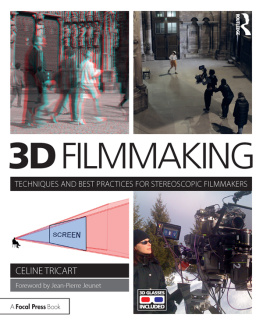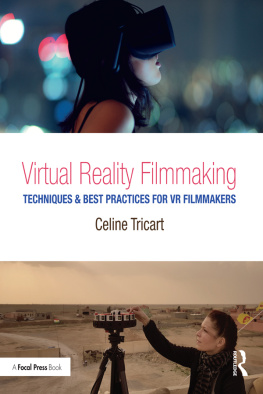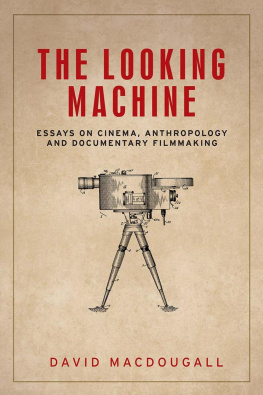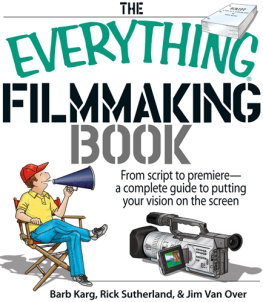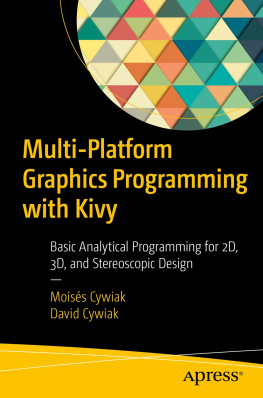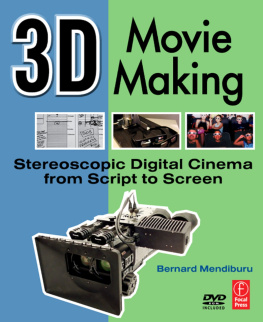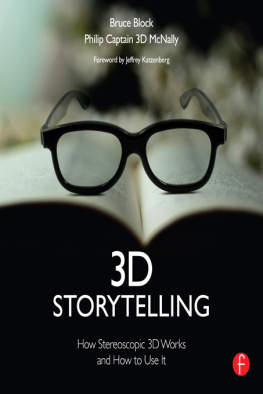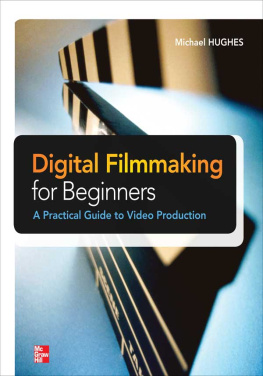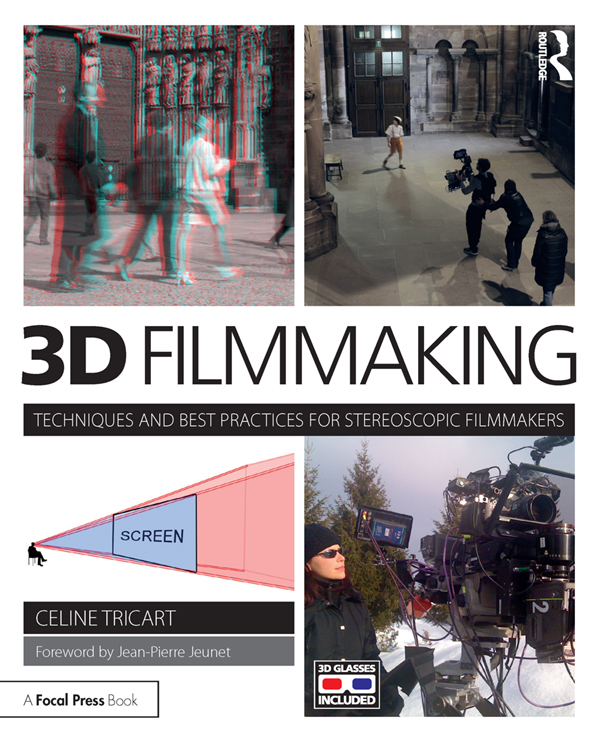3D Filmmaking
A visual book for the visual artist, 3D Filmmaking: Techniques and Best Practices for Stereoscopic Filmmakers provides a comprehensive overview of the theory, language, and methods behind stereoscopic 3D filmmaking, all in one package. Celebrated 3D filmmaker Celine Tricart explores every facet of the art, from the technical to the practical, including:
3D vision
History of 3D cinema
Stereoscopic basics and techniques
How to shoot in 3D
3D VFXs, animation in 3D, and 2D to 3D conversion
Live broadcast in 3D
3D viewing and projection
3D as a storytelling tool
Screenwriting for 3D
Working with a stereographer
3D storyboarding and previz
3D postproduction
Sound design in-depth
A must-read for any 3D filmmaker, producer, writer, or technician interested in the third dimension, 3D Filmmaking covers the history of the form, defines key 3D terms and places them into context, and offers lessons on using the medium as a visual storytelling tool, creating a perfect blend of concepts, practice, and history. Full color throughout, the book also includes a pair of 3D glasses for you to view the 3D images within, and each chapter features detailed color diagrams and examples in anaglyph 3D, as well as interviews with 3D visionaries like Jean Pierre Jeunet (Director, Am9;lie, Alien 4), Chris Sanders (Director, How to Train Your Dragon, The Croods), Demetri Portelli (Stereographer, Hugo), Phil McNally (Stereoscopic Supervisor, How to Train Your Dragon, Madagascar 4), Tim Webber (VFX supervisor, Gravity), Scott Farrar (VFX supervisor, the Transformers franchise), and Victoria Alonso (Stereoscopic Supervisor, Marvel Studios).
A companion website (www.routledge.com/cw/tri-cart) features links to useful resources and footage from 3D films.
Celine Tricart is a filmmaker and stereographer. Since 2008 she has been the stereographer behind more than 20 live 3D broadcasts, commercials, and documentaries, including the first French 3D film, Behind the Walls. Celine also served as a 3D Rig Technician on the 2014 box office hits Stalingrad and Transformers: Age of Extinction.
3D Filmmaking
Techniques and Best Practices for Stereoscopic Filmmakers
Celine Tricart
Foreword by Jean-Pierre Jeunet

First published 2017
by Routledge
711 Third Avenue, New York, NY 10017
and by Routledge
2 Park Square, Milton Park, Abingdon, Oxon, OX14 4RN
Routledge is an imprint of the Taylor & Francis Group, an informa business
2017 Taylor & Francis
The right of Celine Tricart to be identified as author of this work has been asserted by her in accordance with sections 77 and 78 of the Copyright, Designs and Patents Act 1988.
All rights reserved. No part of this book may be reprinted or reproduced or utilised in any form or by any electronic, mechanical, or other means, now known or hereafter invented, including photocopying and recording, or in any information storage or retrieval system, without permission in writing from the publishers.
Trademark notice: Product or corporate names may be trademarks or registered trademarks, and are used only for identification and explanation without intent to infringe.
Library of Congress Cataloging in Publication Data
Tricart, Celine, author.
Techniques and best practices for stereoscopic filmmaker /
Celine Tricart ; preface by Jean Pierre Jeunet.
pages cm
Includes bibliographical references.
ISBN 978-1-138-84789-7 ISBN 978-1-315-72632-8 1. 3-D films.
2. Cinematography. I. Title.
TR854.T75 2016
ISBN: 978-1-138-84789-7 (pbk)
ISBN: 978-1-315-72632-8 (ebk)
Typeset in TimesNewRoman and Optima
by Keystroke, Station Road, Codsall, Wolverhampton
View the online resources for this title: www.routledge.com/cw/tricart
If the companion 3D glasses are missing, send a stamped, self-addressed envelope to the address given below to receive your free replacement pair: American Paper Optics, Inc., RE: 3D Filmmaking, 2995 Appling Rd, Suite 106, Bartlett, TN 38133 USA, 800-767-8427
Contents
I wish to thank all those who helped and supported me during the writing of this book.
In particular, thank you to all the interviewees who devoted considerable time to answer my questions and review my transcripts. Your passion for 3D is incredibly inspiring.
The origin of this book was a dissertation called Making a Film in 3D (2008) that I wrote at the end of my studies at the Ecole Nationale Suprieure Louis Lumire in Paris, France. Thank you to my thesis adviser Pascal Martin, who also helped me with this book, as well as Claude Bailbl.
I would also like to thank Matthew Blute for his help and the tens of hours spent helping me to translate this book from French to English, and Buzz Hays for proofreading this version.
I also want to thank Nick Urbom for his help, as well as my 3D mentors who guided me and supported me throughout my career as a stereographer and director: Yves Pupulin, Ray Zone, and Steve Schklair.
And finally, I warmly thank Jean-Pierre Jeunet, who, despite his busy schedule, has made himself available to answer my questions and to share his vision of 3D storytelling, as well as writing the Foreword.
Jean-Pierre Jeunet
People often ask me why I decided to shoot The Young and Prodigious T.S. Spivet in 3D. The answer is, I think I was looking for something different. I wanted to renew myself and face new challenges.
When I was a kid, I had a stereoscope, a View-Master. Still today, I have incredible memories of it; it was like a magic window for me. With the stereoscope there was a small projector that projected in 2D and helped me take my first steps as a filmmaker: I cut the disks, changed their order, and invented new stories while recording dialogues with friends. The projector would get very hot sometimes and give off a smell; its like my Prousts madeleine today.
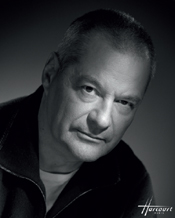
Jean-Pierre Jeunet
As 3D came back into fashion in recent years, I remembered this object from my childhood, and I realized that all my films could have been in 3D: Delicatessen, The City of Lost Children, Alien Resurrection, Amelie, A Very Long Engagement, and especially MicMacs with its cartoony style. Therefore I decided to shoot Spivet in 3D, and I immediately spoke about it with the writer who loved the idea. In his book, there are plenty of diagrams and drawings in the margins that we retranslated in the film by placing them in depth, without being too gimmicky. An opportunity arose to play the out-of-the-screen effects in the service of narrative, like in Amelie where it was said at the time that the special effects were in the service of the poetry of the script.
I quickly realized that low-contrast images and long lenses are not worth it in 3D. I went to see a few 3D films and I tried to assimilate all the things that I thought worked or did not work. Seeing

